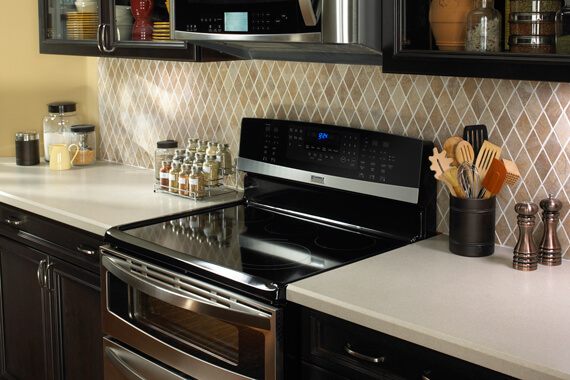When it comes to selecting a range for your kitchen, you have several options to consider. Two popular choices are smooth top ranges and induction ranges. While both offer modern features and sleek designs, they operate differently and provide unique benefits.
In this blog post, we will delve into the differences between smooth top ranges and induction ranges, helping you make an informed decision based on your cooking needs and preferences.
Table of Contents
Smooth Top Range
- Heating Elements:
Smooth top ranges feature radiant heating elements beneath a smooth glass-ceramic cooktop. These elements radiate heat upward, providing a flat and even cooking surface. The heat generated by the elements is transferred to the cookware, allowing for consistent heat distribution during cooking. - Easy Maintenance:
The smooth glass-ceramic surface of a smooth top range is easy to clean. Spills and splatters can be quickly wiped away, and the lack of crevices or coil burners makes it less prone to collecting food debris. However, caution must be taken to prevent scratches or damage to the surface. - Cookware Compatibility:
Smooth top ranges are compatible with a wide range of cookware, including stainless steel, cast iron, and non-stick pans. However, it’s important to note that flat-bottomed cookware is recommended to ensure maximum contact with the heating elements and optimal heat transfer.
Induction Range
- Induction Technology:
Induction ranges utilize electromagnetic technology to directly heat the cookware. When an induction-compatible pot or pan is placed on the cooktop, an electric current generates a magnetic field, causing the cookware to heat up. The heat is produced within the cookware itself, offering precise and efficient cooking. - Rapid Heating and Temperature Control:
One of the key advantages of induction ranges is their rapid heat-up time. Induction technology allows for almost instant heat response, reducing the time needed to bring water to a boil or heat up a pan. Additionally, induction ranges provide precise temperature control, allowing for quick adjustments during cooking. - Energy Efficiency and Safety:
Induction ranges are highly energy-efficient. They deliver heat directly to the cookware, resulting in minimal heat loss. The cooktop surface remains relatively cool to the touch, as the heat is generated within the cookware. This feature enhances safety, reducing the risk of burns or accidents. Some induction ranges also come equipped with automatic shut-off functions, turning off the heat when no cookware is detected or when the pot or pan is removed. - Cookware Requirements:
To use an induction range, you need induction-compatible cookware. Induction cookware is typically made of ferrous (magnetic) materials, such as cast iron or stainless steel. Aluminum, copper, and glass cookware will not work unless they have a magnetic bottom layer. You can easily test the compatibility of your cookware by using a magnet; if it sticks to the bottom of the cookware, it is induction-compatible.
Smooth Top Range vs. Induction
| Features | Smooth Top Range | Induction Range |
|---|---|---|
| Heating Elements | Radiant heating elements beneath a smooth glass-ceramic cooktop | Electromagnetic technology directly heating the cookware |
| Heat Distribution | Even heat distribution with radiant heating elements | Heat generated within the cookware |
| Maintenance | Easy-to-clean smooth glass-ceramic surface | Easy-to-clean smooth glass-ceramic surface |
| Cookware Compatibility | Compatible with a wide range of cookware | Requires induction-compatible cookware (ferrous materials) |
| Heat-Up Time | Gradual heat-up time | Rapid heat-up time |
| Temperature Control | Precise temperature control | Precise temperature control |
| Energy Efficiency | Varies depending on model, moderate efficiency | Highly efficient, minimal heat loss |
| Safety | No open flame, reduced risk of burns | Cool cooktop surface, enhanced safety features |
Conclusion
Choosing between a smooth top range and an induction range depends on your cooking preferences, lifestyle, and budget. Smooth top ranges offer even heat distribution, easy maintenance, and compatibility with a wide range of cookware. Induction ranges provide rapid heating, precise temperature control, energy efficiency, and enhanced safety features.
Consider factors such as heat response time, temperature control, energy efficiency, cookware compatibility, and maintenance when making your decision. By understanding the differences between smooth top ranges and induction ranges, you can select the option that best suits your cooking needs and enhances your overall kitchen experience.

